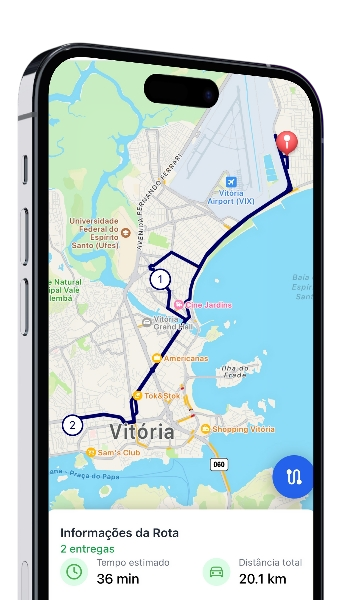Delivery routing consists of the strategic planning of the routes that a fleet's vehicles should follow to carry out deliveries or services in the most efficient way possible. With technological advancements, routing systems have become indispensable tools for companies that rely on efficient deliveries. Check out the 10 main advantages that implementing a routing system can bring to your business:
1. Reduction in operational costs
An efficient routing system allows for the optimization of fuel use, significantly reducing operational costs. By calculating the shortest routes and avoiding traffic jams, the system minimizes transit time and, consequently, fuel consumption. Studies indicate that companies can save between 10% and 30% on fuel costs after implementing efficient routing solutions.
2. Increased productivity
With optimized routes, drivers can complete more deliveries in less time. The elimination of unnecessary routes and the balanced distribution of loads among vehicles enable the team to work more productively. This means more deliveries per day, resulting in increased revenue and customer satisfaction.
3. Improved customer experience
One of the most important aspects of any business is customer satisfaction. Modern routing systems allow for more precise delivery windows, reducing wait times for customers. Additionally, many systems enable real-time notifications about delivery status, increasing transparency and customer trust.
4. Real-time adaptation
Unexpected events such as traffic jams, accidents, or adverse weather conditions are common in daily logistical operations. A good routing system allows for real-time adjustments, recalculating routes when necessary to circumvent obstacles and maintain delivery efficiency.
5. Reduction in carbon emissions
Sustainability has become a growing concern for businesses and consumers. By optimizing routes and reducing unnecessary mileage, routing systems significantly decrease the emission of pollutants. Companies can use this advantage not only to meet environmental goals but also as a competitive market differentiator.
6. Better fleet management
Advanced routing systems offer fleet management tools that monitor vehicle performance, identifying preventive maintenance needs. This reduces the risk of breakdowns during deliveries and extends the lifespan of vehicles, optimizing investment in assets.
7. Data analysis for decision-making
Modern routing systems collect and analyze large volumes of operational data. This information can be transformed into detailed reports on route performance, delivery times, and driver behavior. Based on these insights, managers can make more informed decisions to continuously improve operations.
8. Balanced load distribution
Unequal distribution of deliveries among drivers can lead to delays, stress, and employee dissatisfaction. Routing systems balance the workload, considering factors such as volume, weight, distance, and time required for each delivery, resulting in a fairer and more efficient operation.
9. Integration with other systems
The best routing systems easily integrate with other management tools, such as ERPs, warehouse management systems (WMS), and e-commerce platforms. This integration allows for a continuous flow of information between different departments, eliminating manual errors and increasing the efficiency of the entire logistics chain.
10. Scalability of operations
As your company grows, your logistical operations become more complex. A good routing system grows with your business, allowing for efficient management of larger fleets and broader delivery areas without the need to proportionally increase the logistics planning team.
How "Meu Rastreio" will help you
Implementing a delivery routing system is not just about adopting new technologies, but a strategic decision that directly impacts a business's competitiveness and profitability. The advantages go beyond mere cost reduction, positively affecting customer satisfaction, operational efficiency, and even the company's environmental impact.
With the market becoming increasingly competitive and customers more demanding, investing in technologies that optimize the delivery process is no longer a differentiator, but a necessity for companies that wish to remain relevant in the current scenario.











